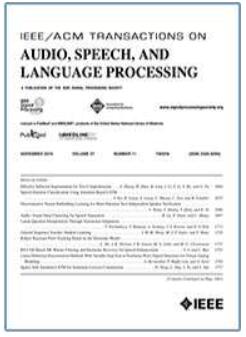反思处理失真:厘清语音增强错误对语音识别性能的影响
IF 5.1
2区 计算机科学
Q1 ACOUSTICS
IEEE/ACM Transactions on Audio, Speech, and Language Processing
Pub Date : 2024-07-22
DOI:10.1109/TASLP.2024.3426924
引用次数: 0
摘要
使用单通道语音增强(SE)前端提高噪声条件下的自动语音识别(ASR)性能是一项挑战。这通常归因于单通道 SE 前端的非线性处理所造成的处理失真。然而,造成这种 ASR 性能下降的原因尚未得到充分研究。如何设计能显著提高 ASR 性能的单通道 SE 前端仍是一个有待研究的问题。在本研究中,我们研究了一种能解释 ASR 性能下降原因的信号级数值指标。为此,我们提出了一种基于正交投影的 SE 误差分解的新型分析方案。该方案可手动修改分解后的干扰、噪声和人工误差的比率,使我们能够直接评估每种误差类型对 ASR 性能的影响。我们的分析表明,与其他类型的误差相比,人工误差对 ASR 性能的影响尤为不利。这为我们提供了导致 ASR 性能下降的处理失真更为原则性的定义。然后,我们研究了减少人工痕迹错误影响的两种实用方法。首先,我们证明了简单的观测添加(OA)后处理(即对增强信号和观测信号进行插值)可以提高信号与伪迹的比率。其次,我们提出了一种新的训练目标,即人工失真增强信号失真比(AB-SDR),它迫使模型以更少的人工失真误差来估计增强信号。通过实验,我们证实 OA 和 AB-SDR 方法都能有效减少单通道 SE 前端造成的伪音误差,从而显著提高 ASR 性能。本文章由计算机程序翻译,如有差异,请以英文原文为准。
Rethinking Processing Distortions: Disentangling the Impact of Speech Enhancement Errors on Speech Recognition Performance
It is challenging to improve automatic speech recognition (ASR) performance in noisy conditions with a single-channel speech enhancement (SE) front-end. This is generally attributed to the processing distortions caused by the nonlinear processing of single-channel SE front-ends. However, the causes of such degraded ASR performance have not been fully investigated. How to design single-channel SE front-ends in a way that significantly improves ASR performance remains an open research question. In this study, we investigate a signal-level numerical metric that can explain the cause of degradation in ASR performance. To this end, we propose a novel analysis scheme based on the orthogonal projection-based decomposition of SE errors. This scheme manually modifies the ratio of the decomposed interference, noise, and artifact errors, and it enables us to directly evaluate the impact of each error type on ASR performance. Our analysis reveals the particularly detrimental effect of artifact errors on ASR performance compared to the other types of errors. This provides us with a more principled definition of processing distortions that cause the ASR performance degradation. Then, we study two practical approaches for reducing the impact of artifact errors. First, we prove that the simple observation adding (OA) post-processing (i.e., interpolating the enhanced and observed signals) can improve the signal-to-artifact ratio. Second, we propose a novel training objective, called artifact-boosted signal-to-distortion ratio (AB-SDR), which forces the model to estimate the enhanced signals with fewer artifact errors. Through experiments, we confirm that both the OA and AB-SDR approaches are effective in decreasing artifact errors caused by single-channel SE front-ends, allowing them to significantly improve ASR performance.
求助全文
通过发布文献求助,成功后即可免费获取论文全文。
去求助
来源期刊

IEEE/ACM Transactions on Audio, Speech, and Language Processing
ACOUSTICS-ENGINEERING, ELECTRICAL & ELECTRONIC
CiteScore
11.30
自引率
11.10%
发文量
217
期刊介绍:
The IEEE/ACM Transactions on Audio, Speech, and Language Processing covers audio, speech and language processing and the sciences that support them. In audio processing: transducers, room acoustics, active sound control, human audition, analysis/synthesis/coding of music, and consumer audio. In speech processing: areas such as speech analysis, synthesis, coding, speech and speaker recognition, speech production and perception, and speech enhancement. In language processing: speech and text analysis, understanding, generation, dialog management, translation, summarization, question answering and document indexing and retrieval, as well as general language modeling.
 求助内容:
求助内容: 应助结果提醒方式:
应助结果提醒方式:


